Introduction: A Singular Light in Danish Art
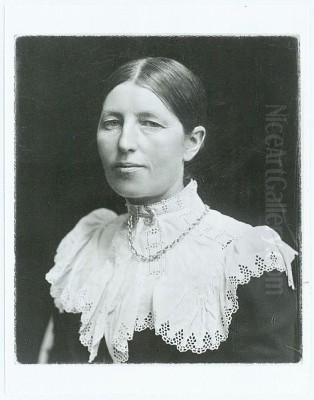
Anna Kirstine Brøndum Ancher (1859-1935) stands as one of Denmark's most cherished and significant visual artists. A central figure within the famed Skagen Painters group, she possessed a unique position as the only member born and raised in the remote fishing village that became their artistic haven. Renowned for her profound sensitivity to light and color, and her intimate portrayals of everyday life, Ancher carved out a distinct artistic identity, blending elements of Realism and Impressionism to capture the quiet moments and domestic scenes of her local community. Her work offers a window into the lives of Skagen's inhabitants, particularly its women and children, rendered with an empathy and mastery that continues to resonate today.
Early Life and Artistic Awakening in Skagen
Anna Kirstine Brøndum was born on August 18, 1859, in Skagen, the northernmost town of Jutland, Denmark. This windswept, light-filled peninsula would become not only her lifelong home but also the primary subject of her art. Her father, Erik Andersen Brøndum, was a merchant and hotelier, running Brøndums Hotel, while her mother, Ane Hedvig Møller, managed the household. The hotel, expanded over the years, became a crucial meeting point for the artists who began flocking to Skagen from the 1870s onwards, drawn by the unique quality of light and the authentic, rugged life of the fishing community.
Growing up surrounded by this burgeoning artistic activity, Anna showed a clear aptitude for drawing and painting from an early age. The presence of visiting artists like Karl Madsen, Viggo Johansen, and later Michael Ancher and P.S. Krøyer, provided an informal, yet stimulating, environment. She observed their techniques and absorbed their discussions, nurturing her innate talent within the very landscape and community that would define her oeuvre. Unlike the visiting artists who came seeking Skagen's exoticism, Anna painted her world from the inside out.
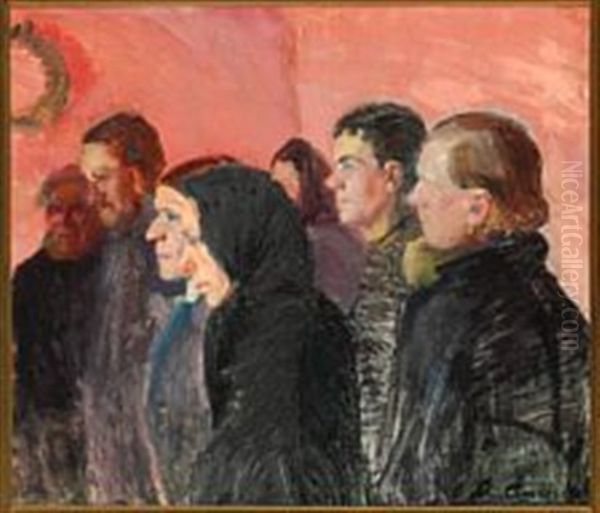
Her family supported her artistic inclinations, a notable stance in an era when professional artistic careers for women were not widely encouraged or facilitated. This supportive environment, coupled with the constant presence of practicing artists at the hotel, gave her a unique start, immersing her in the world of art before she even sought formal training. The scenes she witnessed daily – the fishermen, their wives mending nets, children playing, the interiors of local homes illuminated by the distinctive Skagen light – became the bedrock of her artistic vision.
Formal Training and Development
Recognizing her potential, Anna sought formal instruction. However, the Royal Danish Academy of Fine Arts in Copenhagen did not admit women at that time. Consequently, she pursued private education. For three consecutive winters, starting around 1875, she attended Vilhelm Kyhn's Private School of Painting for Women in Copenhagen. Kyhn, a respected landscape painter, provided foundational training, though his traditional approach sometimes clashed with the emerging modern styles. Despite this, the structured learning environment was crucial for honing her technical skills.
Her time in Copenhagen exposed her to a broader art scene, but Skagen remained her artistic anchor. She returned home each summer, applying her developing skills to the subjects she knew best. Her connection to the Skagen milieu deepened when she became engaged to the painter Michael Ancher, one of the early members of the artists' colony, in 1877.
Seeking further development and exposure to contemporary European art trends, Anna traveled to Paris. She studied in the atelier of Pierre Puvis de Chavannes, a prominent Symbolist painter known for his monumental decorative works. While his style differed significantly from her own developing focus on intimate realism and light effects, the experience broadened her horizons. In Paris, she studied alongside other aspiring artists, including Marie Triepcke, who would later marry P.S. Krøyer, another leading figure in the Skagen group. This period abroad, though perhaps not directly shaping her core style, undoubtedly enriched her understanding of composition and form and connected her to international currents.
Marriage, Family, and the Skagen Colony
Anna Brøndum married Michael Ancher (1849-1927) on her twenty-first birthday, August 18, 1880. Their union was both a personal partnership and an artistic one. Michael was already an established figure within the Skagen Painters, known for his heroic depictions of the local fishermen. Together, they became a central couple in the social and artistic life of the colony. They initially lived in the Garden House at Brøndums Hotel.
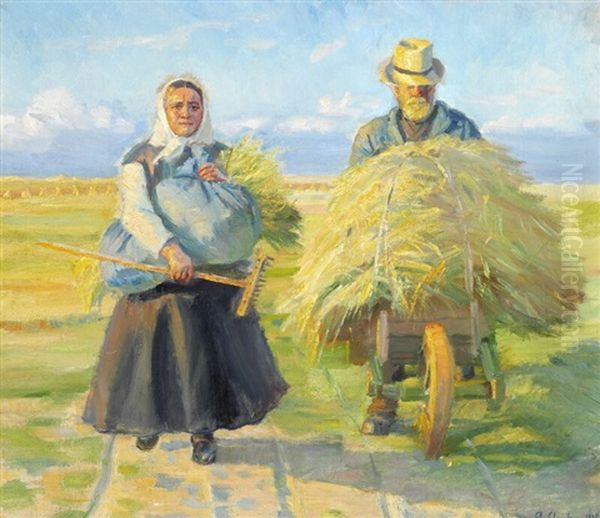
In 1883, their only child, Helga Ancher, was born. Helga would also become an artist. The following year, in 1884, the family purchased a house on Markvej in Skagen. This house, later expanded, became their permanent home and studio, a place filled with art, family life, and frequent gatherings of fellow artists. It served as a hub for the Skagen Painters, embodying the blend of domesticity and artistic pursuit that characterized Anna's life and work.
Life within the Skagen colony was vibrant and collaborative, though not without its professional rivalries and personal dramas. Anna, known for her quiet and observant nature, navigated this world with grace. While Michael focused on the dramatic, often outdoor scenes of fishermen's lives, Anna turned her gaze more frequently inward, exploring the domestic sphere, the subtle play of light in interiors, and the inner lives of her subjects, primarily women and children. Their home, filled with paintings by themselves and their friends, reflected this rich artistic environment.
The Skagen Painters: A Unique Artistic Milieu
The Skagen Painters were not a formal school with a manifesto but rather a colony of artists drawn to the same location for its unique qualities. Active mainly between the late 1870s and the turn of the century, they shared an interest in Realism and Plein Air (open-air) painting, aiming to depict the local life and landscape truthfully. Key figures included Michael Ancher, P.S. Krøyer, Laurits Tuxen, Christian Krogh (though Norwegian, a frequent visitor and influence), Viggo Johansen, Karl Madsen, Carl Locher, Oscar Björck (Swedish), and Thorvald Niss. The poet and painter Holger Drachmann was also associated with the group.
What particularly attracted them was the extraordinary natural light of Skagen, where the Skagerrak and Kattegat seas meet. The vast beaches, dunes, and the quality of the summer light, especially the famous "blue hour" after sunset, provided endless inspiration. They sought to capture the effects of this light with a new vibrancy, influenced partly by French Impressionism but adapted to their Nordic environment and Realist inclinations.
Anna Ancher was integral to this group, respected for her talent and unique perspective. While sharing the group's interest in light and everyday subjects, her approach was often more intimate and psychologically nuanced than the sometimes more monumental or anecdotal works of her male colleagues. She participated in their social life and artistic discussions, contributing significantly to the colony's output and spirit. Her status as a native Skagbo gave her an inherent understanding of the community they depicted.
Anna Ancher's Artistic Style: Light, Color, and Intimacy
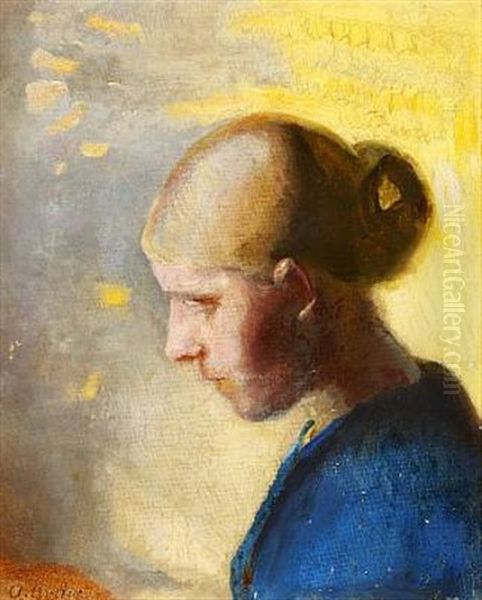
Anna Ancher's style is characterized by its masterful handling of light and color, combined with a sensitive, unpretentious approach to her subjects. While often associated with Impressionism due to her focus on light effects and sometimes visible brushwork, her work retains a strong foundation in Realism, particularly in its truthful depiction of people and environments.
Light is arguably the central protagonist in many of her paintings. She was fascinated by the way sunlight fell into a room, illuminating dust motes, reflecting off surfaces, and defining form and space. Works like Sunlight in the Blue Room (1891) are celebrated studies of indoor light, capturing not just its visual appearance but also its mood-altering effects. She explored sunlight, candlelight, and lamplight, observing the subtle shifts in color and atmosphere they created.
Her use of color was often bolder and more experimental than that of many contemporaries. She wasn't afraid to use pure, bright colors, particularly yellows, blues, and pinks, juxtaposing them to create vibrant effects, sometimes hinting at the influence of Impressionist color theory regarding complementary colors. However, her color always served the depiction of reality and mood, rather than becoming an abstract element in itself. Her palette captured the specific chromatic qualities of the Skagen environment – the intense blue of the sea and sky, the warm tones of interiors, the sun-bleached exteriors.
Ancher often employed relatively thick brushstrokes, giving her paintings texture and emphasizing the materiality of paint. Yet, her technique was versatile, adapted to the subject and desired effect. Her compositions are typically straightforward and balanced, focusing attention on the figures and the play of light without unnecessary clutter. There is an inherent quietness and intimacy in her work, drawing the viewer into the private moments she depicts.
Themes and Subjects: The Fabric of Skagen Life
Anna Ancher's subject matter was drawn directly from her immediate surroundings in Skagen. She painted the world she knew intimately, focusing on the human element within it. Unlike Michael Ancher's focus on the heroic struggles of fishermen at sea, Anna concentrated on the domestic sphere and the less dramatic, yet equally vital, aspects of community life.
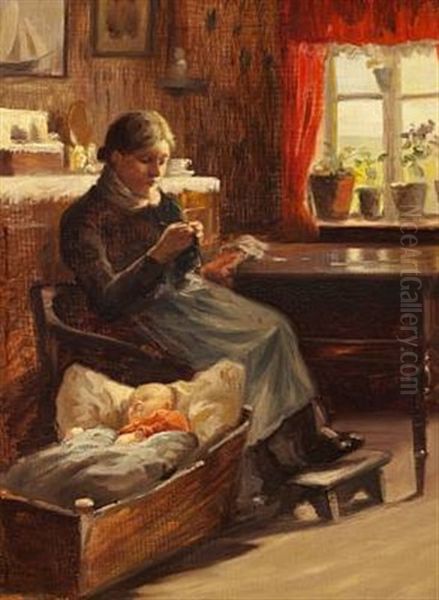
Women and children are central figures in her oeuvre. She depicted women engaged in everyday tasks: sewing, reading, preparing food, tending to children, or simply caught in moments of quiet contemplation. These portrayals are notable for their dignity and psychological depth, avoiding sentimentality. Works like The Girl in the Kitchen (c. 1883-86) or Wife of Fisherman Sewing (1890) elevate ordinary domestic labor through sensitive observation and masterful light effects. She often painted her mother, her daughter Helga, and local Skagen women, capturing their likenesses and suggesting their inner lives.
Interiors were a favorite setting. She explored the humble homes of the fishing families as well as the rooms of her own house and her parents' hotel. These interior scenes allowed her to focus on the interplay of light and shadow, texture, and color within contained spaces. The furniture, textiles, and simple objects within these rooms are rendered with care, contributing to the overall atmosphere and narrative.
While primarily a painter of everyday life, religious themes occasionally appear, often integrated into the local context. A Sermon (or A Field Sermon, 1890/1903 version) depicts an outdoor religious gathering, while A Vaccination (1899) shows a group of mothers and children awaiting inoculation, a scene imbued with quiet solemnity and communal concern. A Funeral (1891) is a powerful depiction of collective grief within the community. These works reflect the importance of faith and communal rituals in Skagen life.
She also painted portraits and, less frequently, pure landscapes, always grounded in the specific environment of Skagen. Her deep connection to the place and its people permeates all her work, giving it authenticity and emotional resonance.
Key Masterpieces: A Closer Look
Several paintings stand out as particularly representative of Anna Ancher's artistic achievements:
Sunlight in the Blue Room (1891, Skagens Museum): Perhaps her most famous work, this painting depicts her daughter Helga in a room painted a distinctive blue, with sunlight streaming through the window. A yellow curtain casts a warm glow, and a shaft of light illuminates the child's golden hair. It is a quintessential Ancher study of indoor light, color interaction, and quiet domesticity. The painting captures a fleeting moment with remarkable sensitivity to atmosphere.
A Funeral (1891, Statens Museum for Kunst): This larger composition shows a group of somber Skagen men gathered for a funeral service inside a simple room. The light comes from a window to the left, illuminating the faces and dark clothing. It's a powerful portrayal of communal grief and solidarity, rendered with stark realism and emotional weight, showcasing her ability to handle multi-figure compositions and convey deep emotion.
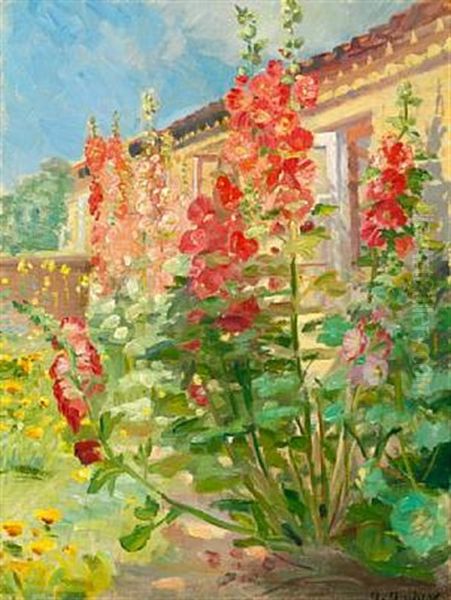
Harvesters (1905, Skagens Museum): Depicting farm workers, including women, during the harvest season, this painting showcases Ancher's skill in rendering figures in an outdoor setting, bathed in the warm light of late summer. It highlights the theme of labor, common in Realist painting, but treated with her characteristic sensitivity to light and individual presence.
The Girl in the Kitchen (c. 1883-86, The Hirschsprung Collection): A young woman stands preparing food in a rustic kitchen, illuminated by light from an unseen window. The simple scene is elevated by the nuanced handling of light on different surfaces – the girl's white cap, the copper pot, the textured walls. It exemplifies Ancher's ability to find beauty and significance in the most ordinary moments of daily life.
A Vaccination (1899, Skagens Museum): This painting depicts a group of mothers with their infants gathered in a room, likely awaiting a doctor for vaccinations. The mood is one of quiet apprehension and maternal care. Ancher captures the individual expressions and postures, creating a scene that is both a social document and a study in human emotion, unified by the soft interior light.
These works, among many others, demonstrate Anna Ancher's consistent focus on light, color, domesticity, and the human condition within the specific context of Skagen.
Collaboration and Influence: Interactions with Peers
Anna Ancher's artistic journey was deeply intertwined with her relationships with fellow artists. Her marriage to Michael Ancher was a lifelong artistic dialogue. While their styles and primary subjects differed, they undoubtedly influenced each other, sharing critiques, models, and the daily experience of artistic creation. Michael's respect for Anna's talent is evident, and her distinct artistic voice remained clear throughout their life together. Their home was a testament to their shared world, filled with both their works.
The Skagen Painters group provided a dynamic environment of mutual influence. Anna learned from and contributed to the collective exploration of light and Realism. She had a close relationship with P.S. Krøyer and his wife Marie Krøyer. Marie, also a talented painter who had studied with Anna in Paris, faced greater challenges in pursuing her art after marriage. Anna, however, managed to maintain a prolific career alongside her family responsibilities, becoming a role model in that respect.
Her teachers, Vilhelm Kyhn in Copenhagen and Puvis de Chavannes in Paris, provided formal training that shaped her technique and understanding, even if she ultimately forged her own path stylistically. Kyhn grounded her in traditional Danish landscape and genre painting, while Puvis exposed her to broader European trends.
Beyond the Skagen circle, Anna Ancher was also involved in efforts to support female artists. Along with sculptor Anne Marie Carl-Nielsen (wife of composer Carl Nielsen) and others, she was involved in the founding of the Danish Female Artists' Society (Kvindelige Kunstneres Samfund) in 1916, an organization aimed at improving exhibition opportunities and recognition for women artists in Denmark. This demonstrates her awareness of the specific challenges faced by women in the art world and her commitment to collective advancement.
Exhibitions, Recognition, and Legacy
Anna Ancher exhibited her work regularly throughout her career, primarily at the Charlottenborg Spring Exhibition in Copenhagen, the main venue for Danish artists at the time. She gained recognition early on and was respected by critics and fellow artists alike. In 1904, she received the Eckersberg Medal, a prestigious Danish art award. In 1913, she was awarded the Ingenio et Arti medal by King Christian X, a high honor recognizing contributions to science and art.
Her works were acquired by major Danish museums during her lifetime, including the Statens Museum for Kunst (National Gallery of Denmark) and the Hirschsprung Collection in Copenhagen. The largest collection of her work today resides, fittingly, at the Skagens Museum, located in the heart of the town she depicted. The museum, founded in 1908 by Michael Ancher, P.S. Krøyer, and Laurits Tuxen among others, is dedicated to preserving the legacy of the Skagen Painters.
Internationally, while the Skagen Painters remained somewhat niche compared to French Impressionism, Anna Ancher's work has gained increasing recognition in recent decades. Exhibitions outside Denmark, such as the 2020 show "A World Apart: Anna Ancher and the Skagen Art Colony" at the National Museum of Women in the Arts in Washington D.C., have introduced her art to a wider audience, highlighting her unique talent and contribution.
Anna Ancher's legacy is that of a pioneering female artist who created a deeply personal and technically brilliant body of work. She captured the soul of Skagen, particularly its inner life, with unparalleled sensitivity to light and color. She stands as a major figure not only within the Skagen group but in the broader context of Scandinavian and European art of the late 19th and early 20th centuries.
Anchers Hus: A Living Museum
After Michael Ancher's death in 1927 and Anna's death in 1935, their daughter Helga Ancher inherited the house on Markvej. Helga, who never married and lived in the house until her own death in 1964, stipulated in her will that the house and its contents should be preserved as a museum.
Anchers Hus (Ancher's House) opened to the public in 1967. It remains almost exactly as it was when Anna and Michael lived there, offering an extraordinary glimpse into their lives and artistic environment. The studios are preserved with easels, paints, and unfinished canvases, while the living areas are filled with their furniture, personal belongings, and an extensive collection of artworks by themselves and their artist friends, including P.S. Krøyer, Laurits Tuxen, and Viggo Johansen. Visiting the house provides invaluable context for understanding Anna Ancher's work, showing the intimate connection between her life, her home, and her art. It is now part of the Art Museums of Skagen.
Conclusion: An Enduring Vision
Anna Ancher holds a unique and revered place in art history. As the Skagen Painter born in Skagen, she offered an insider's perspective, portraying her community with profound empathy and understanding. Her focus on the domestic sphere, the lives of women and children, and the subtle effects of light within interiors provided a crucial counterpoint to the more outwardly dramatic subjects often favored by her male colleagues.
Her mastery of color and light places her among the foremost Scandinavian artists of her generation. She successfully navigated the challenges faced by female artists of her time, creating a substantial and consistently high-quality body of work while raising a family and participating actively in the artistic community. Her paintings transcend mere documentation; they are poetic explorations of everyday existence, imbued with quiet emotion and a deep appreciation for the beauty found in ordinary moments and the transformative power of light. Anna Ancher's art continues to captivate viewers with its intimacy, authenticity, and luminous vision.